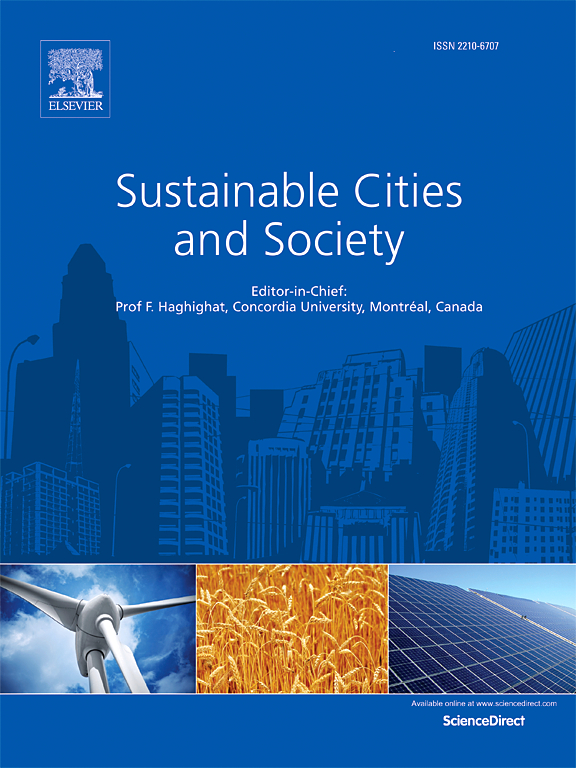Cancer risk and sick building syndrome in different regions of China: Potential hazard from particulate matter and phthalate pollutants
IF 10.5
1区 工程技术
Q1 CONSTRUCTION & BUILDING TECHNOLOGY
引用次数: 0
Abstract
Phthalates (PAEs), a class of synthetic chemicals, are harmful to human health and found in indoor particulate matter (PM), air and settled dust. Current risk assessments for indoor PAEs may not accurately reflect the risks for the Chinese population because they use parameters from the U.S. Environmental Protection Agency (U.S. EPA.). This study investigated the correlation among PAEs, PM and Sick Building Syndrome (SBS) in Shanghai. Chinese exposure parameters were then used to assess the lifetime incremental cancer risk (ILCR) of di(2-ethylhexyl) phthalate (DEHP) for different age groups across various Chinese regions. A significant positive correlation was found between indoor PAEs, PM concentrations (PM2.5, PM4 and PM10) and SBS. Regional differences existed in the ILCR associated with non-dietary intake (ILCRintake) and inhalation (ILCRinhale) of DEHP. ILCRintake posed a higher risk than ILCRinhale, exceeding the U.S. EPA limit (1 × 10−6) in most regions (1.19 × 10−6 to 1.93 × 10−6) with the exception of North and South China. . ILCRinhale remained below this threshold (ranging from 0.01 × 10−6 to 0.75 × 10−6). These findings highlight that cancer risks from DEHP intake via dust warrant particular concern.

中国不同地区的癌症风险和病态建筑综合征:来自颗粒物和邻苯二甲酸盐污染物的潜在危害
邻苯二甲酸酯(PAEs)是一类合成化学品,对人体健康有害,存在于室内颗粒物(PM)、空气和沉降尘埃中。目前对室内PAEs的风险评估可能无法准确反映中国人群的风险,因为他们使用的是美国环境保护署(U.S. EPA)的参数。本研究探讨了上海市PAEs、PM与病态建筑综合征(SBS)的相关性。然后使用中国暴露参数来评估中国不同地区不同年龄组邻苯二甲酸二(2-乙基己基)酯(DEHP)的终生增量癌症风险(ILCR)。室内PAEs、PM浓度(PM2.5、PM4和PM10)与SBS呈显著正相关。非膳食摄入(ILCRintake)和吸入(ilcr吸气)与DEHP相关的ILCR存在区域差异。除华北和华南地区外,大多数地区(1.19 × 10−6至1.93 × 10−6)的ILCRintake的风险高于ILCRintake的风险,超过了U.S. EPA的限值(1 × 10−6)。ilcr吸气保持在该阈值以下(范围从0.01 × 10−6到0.75 × 10−6)。这些发现强调,通过灰尘摄入DEHP的癌症风险值得特别关注。
本文章由计算机程序翻译,如有差异,请以英文原文为准。
求助全文
约1分钟内获得全文
求助全文
来源期刊

Sustainable Cities and Society
Social Sciences-Geography, Planning and Development
CiteScore
22.00
自引率
13.70%
发文量
810
审稿时长
27 days
期刊介绍:
Sustainable Cities and Society (SCS) is an international journal that focuses on fundamental and applied research to promote environmentally sustainable and socially resilient cities. The journal welcomes cross-cutting, multi-disciplinary research in various areas, including:
1. Smart cities and resilient environments;
2. Alternative/clean energy sources, energy distribution, distributed energy generation, and energy demand reduction/management;
3. Monitoring and improving air quality in built environment and cities (e.g., healthy built environment and air quality management);
4. Energy efficient, low/zero carbon, and green buildings/communities;
5. Climate change mitigation and adaptation in urban environments;
6. Green infrastructure and BMPs;
7. Environmental Footprint accounting and management;
8. Urban agriculture and forestry;
9. ICT, smart grid and intelligent infrastructure;
10. Urban design/planning, regulations, legislation, certification, economics, and policy;
11. Social aspects, impacts and resiliency of cities;
12. Behavior monitoring, analysis and change within urban communities;
13. Health monitoring and improvement;
14. Nexus issues related to sustainable cities and societies;
15. Smart city governance;
16. Decision Support Systems for trade-off and uncertainty analysis for improved management of cities and society;
17. Big data, machine learning, and artificial intelligence applications and case studies;
18. Critical infrastructure protection, including security, privacy, forensics, and reliability issues of cyber-physical systems.
19. Water footprint reduction and urban water distribution, harvesting, treatment, reuse and management;
20. Waste reduction and recycling;
21. Wastewater collection, treatment and recycling;
22. Smart, clean and healthy transportation systems and infrastructure;
 求助内容:
求助内容: 应助结果提醒方式:
应助结果提醒方式:


